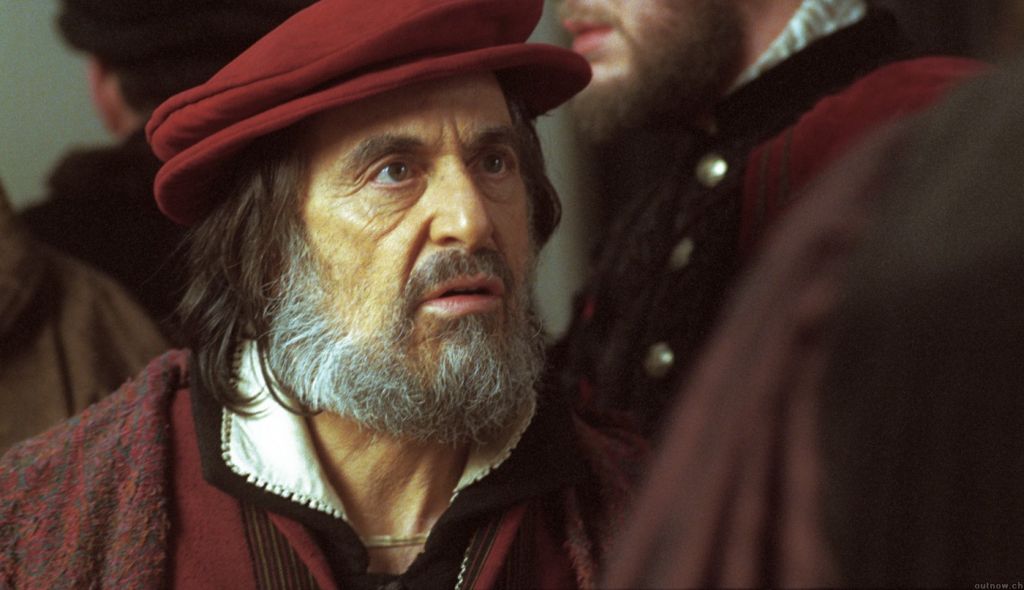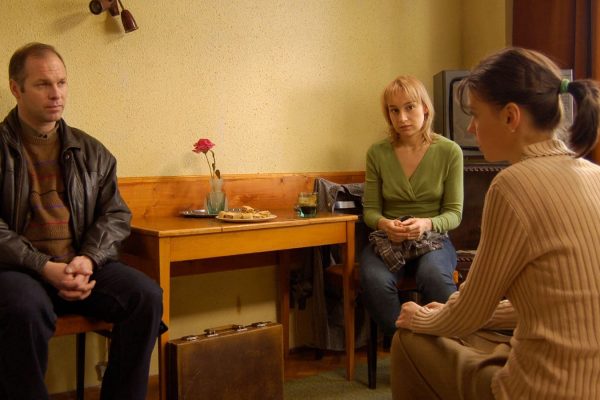The Merchant of Venice
Michael Radford
Sony Pictures Classics
There had never before been a big-screen version of Shakespeare’s The Merchant of Venice—Orson Welles had given up in the middle of rehearsals, and Laurence Olivier did a stage production but could not raise enough money to make a complete film. If you agree with Harold Bloom, these failures were a good thing. Bloom, who has wrestled for decades with The Merchant of Venice and with the efforts of Shakespeare revisionists to reinterpret Shakespeare’s genius for modern consumption, remains convinced that the play is irredeemably anti-Semitic: “It would have been better for the last four centuries of the Jewish people,” Bloom writes, “had Shakespeare never written the play.” In fact The Merchant of Venice was so admired and so often performed in German theaters in the 1920s and during the Third Reich that some Jews still living in the shadow of the Holocaust draw a line from Shylock to Auschwitz.
Barry Navidi, the producer of last year’s big-screen version of The Merchant of Venice, had a quite different reaction to the play. Like other “revisionists,” Navidi understood the play as Shakespeare’s “realistic” portrayal of the anti-Semitism of his age, not as an indictment of the Jewish people. Intrigued by the challenge of producing the first big-screen version, Navidi, who is British, teamed up with the American producer Cary Brokaw and convinced the British director Michael Radford (Il Postino) to adapt the play into a screenplay and direct the movie. When Radford confessed that he had no professional experience with Shakespeare, Navidi thought, “All the better.” With similar irreverence, Cary Brokaw got Al Pacino to play Shylock; Pacino would put people in the seats, but not because of his vast experience as a Shakespearean actor.
Out of this unconventional approach to Shakespeare’s genius has come a remarkable movie with a stunning performance by Al Pacino. Pacino acknowledges that much of the credit for his performance belongs to Radford, who reimagined Shylock and transformed Shakespeare’s unwieldy, anti-Semitic farce into an important movie for modern audiences. According to the Forward, Radford’s The Merchant of Venice has the Anti-Defamation League’s seal of approval, this despite the fact that one of the first ADL campaigns after its founding in 1913 was to convince school superintendents to remove The Merchant of Venice from their curricula.
James Shapiro, the most respected Shakespeare revisionist (and the author of Shakespeare and the Jews), has argued that in Elizabethan times, Shylock was the embodiment of the alien other in the British mind. He writes, “Much of the play’s vitality can be attributed to the ways in which it scrapes against a bedrock of beliefs about the racial, national, sexual, and religious difference of others. I can think of no other literary work that does so as unrelentingly and as honestly.” While it is possible to interpret the play as an honest exploration of such issues rather than as reinforcement of them, such interpretation conflicts with the text’s plain meaning—the meaning that English and Irish audiences saw and enjoyed for centuries in what was always one of Shakespeare’s most popular plays. What they relished was Shakespeare’s farce, not his scraping against a bedrock of beliefs, nor his portrayal of the anti-Semitism of his age.
Their Shylock had a huge nose, red wig, and beard that immediately identified him as Judas Iscariot, spawn of the devil. He had stepped out of the medieval morality play, and when Antonio, The Merchant of Venice, borrows the 3,000 ducats and signs the bond, Man has made a pact with the Devil. Yes, Shylock is more human and less fiend than Marlowe’s Jew of Malta. But Bloom asserts that the most often quoted lines about the Jew as human being—“If you prick us, do we not bleed? if you tickle us, do we not laugh?”—do not redeem Shakespeare’s anti-Semitic caricature when read and understood in context.
These lines come from a speech that supposedly demonstrates (according to the revisionists) that Shakespeare’s universal humanism rises above anti-Semitic stereotypes. But in the first line of his speech, Shylock intransigently declares that he will use Antonio’s pound of flesh “to bait fish withal: if it will feed nothing else, it will feed my revenge.” The speech proclaims that Jew and Christian are alike in their carnal human nature, not their spirituality. And near the end of the speech, Shylock protests that he has learned the villainy of revenge from Christian example. Audiences who had been taught that Christ’s central teaching was forgiveness might hear in the final lines of that speech—“If we are like you in the rest, we will resemble you in [revenge]”—another demonstration of the intransigent, truth-twisting Jew. Bloom adds that Shakespeare’s skeptical irony, which pervades the entire play, goes missing whenever Shylock speaks: “His utterances manifest a spirit so potent, malign, and negative as to be unforgettable.”
Shakespeare’s anti-Semitism is no more subtle or nuanced than the formulaic anti-Semitism of Luther (the “stiff-necked” Jew), the Spanish Inquisition, and the teachings of the Church. Antonio says famously, alluding to Shylock, that “the devil can cite Scripture for his purpose.”
Whether Shakespeare knew any actual Jews is uncertain, but both he and his audience had learned about the Jewish type in their churches. Shakespeare’s work is filled with biblical references, and some of the more compelling analyses of The Merchant of Venice examine its religious borrowings. The court scene echoes the Gospel according to St. Mathew: Antonio becomes a Christ figure, and Shylock is the embodiment of the post-Advent Jew who repudiates his own messiah. To Portia’s eloquent plea that Shylock be merciful and to her admonition that justice is not “salvation,” Shylock angrily responds, “My deeds upon my head.” Those words resonate with the passage of the Gospel in which the rabbis reject Pilate’s offer of mercy for Jesus and respond, “Let the blood be on our heads and our children’s heads.” And Shylock adds, “I have a daughter: / Would any of the stock of Barrabas / Had been her husband rather than a Christian!” In the Gospels, Barrabas is the murderer chosen by the Hebrews for reprieve instead of Jesus.
Shylock’s lines express the core of Christian anti-Semitism—the Jews as Christ-killers—and the trial scene is a struggle between New Testament and Old, between Christian mercy and Jewish vengeance. Bloom, who venerates Shakespeare’s moral genius, suffers under his reading of the play’s cruel anti-Semitism. He laments, “Why did Shakespeare allow Antonio [his] final turn of the torturer’s screw?”—that is, Shylock’s forced conversion. Think of the play as a comedy and the answer seems rather obvious: Portia’s mercy falling from heaven taken together with Antonio’s final turn of the screw adds up to a comic improvised Inquisition, as the Jew converts under pain of death. Shakespeare’s anti-Semitism is revealed not just in the character of Shylock, but in the entire crowd-pleasing comic structure of The Merchant of Venice. The stiff-necked, usurious, vengeful Jew gets his comeuppance from Portia, a woman dressed as a man: that is funny. He is forced to accept as Christian charity from Antonio the return of half of his own hard-earned ducats: that is funnier. But his forced conversion, Antonio’s final turn of the screw, makes a hilarious ending, Shylock’s soul is saved.
Did Shakespeare and his audience think that way? There is every reason to believe they did. Whether Shakespeare was Protestant or (as scholars now suggest) Catholic, both religions preached that post-Advent Jews went to hell. Shylock, demanding Old Testament justice, gets baptized and saved in Shakespeare’s comic ending.
* * *
The only way to redeem such a play after the Holocaust was to turn Shakespeare’s comedy into a tragedy, with Shylock, the Judas Iscariot caricature, as a tragic figure. That, of course, is what modern versions of the play try to do. Shylock becomes a victim of anti-Semitism, not a justification for the audience’s prejudices. Olivier did that kind of Shylock in the 1973 filmed version of the theatrical production directed by Jonathan Miller. They made a sympathetic Shylock in the likeness of Benjamin Disraeli—a Jew envied for his wealth rather than hated as a Christ-killer. Olivier customarily cut other characters’ lines to privilege his character’s own in his Shakespeare productions, and his Merchant of Venice treats Shylock as the main character. In fact Shylock has only some 360 lines in the standard editions and is the third or fourth leading role.
Centuries before Olivier, actors had recognized the challenge of making Shylock the dramatic center of the play. In 1701 George Grainville rewrote the play and renamed it The Jew of Venice. In the century that followed, portrayals of Shylock ranged only from the comic to the fiendish. It was the legendary actor Edmund Kean who broke away from the red hair and beard and began, in 1814, the project of humanizing Shylock by donning a black wig and portraying a Jew “more sinned against then sinning.”
Radford’s initial strategy for continuing this humanizing project was to create backstories for the major characters. A backstory, in theory, would give Shylock, Portia, Antonio, and the others a psychobiographical foundation that would be the platform for the actors’ interpretations of their roles, on the assumption that character is the record of individual experience.
Had Radford persisted in this effort, Shakespeare’s iconic figures would have been reduced to their psychologies. Fortunately, Radford recognized the hubris of this effort and gave it up. Instead he focused on visualizing a “realistic” film. His idea of realism was informed by looking to the great artists of the 17th century for guidance. When, for example, the Spanish Prince of Aragon visits Portia to seek her hand in marriage, his retinue seems to have been drawn right out of Velázquez’s Las Meninas. Moreover, Radford decided to shoot on location in Venice, a city whose Renaissance appearance has both been preserved and memorialized in great paintings. His formula for movie realism also included throngs of extras to create the hustle and bustle of Venice as the commercial center of the Western world.
And there is another kind of realism, a bordello with topless prostitutes and rouged nipples. Nothing is gratuitous, and these images, too, contribute to Radford’s visual hypertext. The bordello is of course Radford’s invention, and its presence emphasizes the dissolute and hypocritical behavior of the Venetians, who claim the moral superiority of their Christian faith. Radford provides a transforming context for Shylock’s plea that Jews are human beings: if Shylock’s great speech rests on the common carnal nature of Jews and Christians, then have Pacino deliver it in front of the bare-breasted whores favored by Antonio’s carnal Christian friends.
The most compelling visual inventions are displayed before the first line is spoken. The Merchant of Venice’s underlying religious contest between Christians and Jews, between Old Testament and New, is prefigured in the opening scenes of the movie. The first image is of a baleful priest with a huge wooden crucifix beside him, sitting in a gondola in one of the canals. Words describing the persecution of the Jews in Venice appear on the screen; next we see the sacred Talmud in flames and hear a mournful Jewish choir in the background.
The culmination of this opening montage is another fanatical priest in a gondola approaching the Rialto Bridge in the Grand Canal. The priest is holding a crucifix and preaching that usury is a sin that should be punished by death. The mob standing on the Rialto grabs an offending Jew and throws him into the canal. These images, none of them in Shakespeare’s play, show us how Christians and the Church treat the Jews of Venice. To underscore that reality and to establish the character of Antonio, he is shown wearing a large crucifix around his neck, and when Shylock greets him Antonio spits in his face: apparently he is the embodiment of the Church’s hatred of usurious Jews. Afterward we follow the Jew to his synagogue and eventually to a kosher slaughterhouse, where we witness the ritual killing of a goat, its throat slit with a blade. The ritual slaughter is another of Radford’s eye-catching visual inventions.
Bassanio, the prodigal young Venetian who needs the 3,000 ducats to mount his courtship of Portia, pursues Shylock to the kosher butcher shop imploring him to lend Antonio the money. As their colloquy continues we are shown Shylock purchasing the freshly killed and bloodless goat meat. It is wrapped in cloth, and Shylock carries it home in hand as he and Antonio discuss the loan. All this is Radford’s attempt to explain (has there ever before been a human explanation?) why Shylock asks for a pound of flesh as surety against the forfeiture of the loan. Shylock hefts his newly purchased goat meat, and it seems to inspire a whim—a pound of Antonio’s flesh.
Pacino has said that at 64 he felt old enough to play Shylock. This intuition was important; age adds shades of King Lear to Pacino’s Shylock. Radford helps Pacino into his Shylock by having Antonio spit in his face. For Shylock, this is not just impersonal anti-Semitism: he reaches out to greet the merchant, calls him by name, and Antonio spits in his face with malice and contempt. Pacino’s elderly Shylock tolerates the affront, maintains his personal dignity, and then comes to Bassanio and implores him to lend Antonio the ducats. The question posed so pointedly to this Shylock is, What is the value of self-respect? What price could he charge Antonio that would compensate him for the insult he has just received? Shylock consults the tables of interest, hefts his bag of meat; no monetary price can compensate his pride, and thus the pound of flesh. When his daughter elopes with a Christian, Pacino dissolves into tears. As he counts his losses his rage grows, as does his seeming madness.
By the time Shylock comes to court demanding his bond and sharpening his knife, he is a crazed old man sustained by rage. Rage is, of course, one of our best defenses against depression, but like other forms of madness it isolates us from others, locks us into a prison of our passion. Pacino’s Shylock is not a Jewish fiend but a pitiable old man clinging to his rage who leaves the trial in misery, stripped of his self-respect. Although Radford reconceptualized Shylock so that Pacino could make him tragically human, Radford also left in the lines that echo the Gospels. I can only assume that Radford wanted to remind us that in the contest between Christians and Jews there is bigotry as well as humanity on both sides. And it is my assumption that it is for the same reason that Shakespeare himself gave Shylock those amazing lines attacking the Christians in the trial scene: “You have among you many a purchased slave.”
The friendship between Antonio (Jeremy Irons) and Bassanio (Joseph Fiennes) is complicated by a homoerotic connection between the two men. Antonio opens the play by saying, “In sooth, I know not why I am so sad: / It wearies me; you say it wearies you.” The psychoanalytic explanation of this mysterious depression is that Antonio has an unconscious loss that he cannot acknowledge. Bassanio, whom he loves, is abandoning him to go courting the wealthy Portia.
If one recognizes the rivalry between Antonio and Portia for Bassanio’s love then all three of these characters come to life in a new way. The hijinks surrounding the ring Portia gives to Bassanio and then, disguised, takes back from him at Antonio’s urging is no longer just a superfluous comic wrinkle; it is an essential element in the play. It emphasizes the conflict between Bassanio’s devotion to his old friend and his love for his new wife. In Radford’s movie, when Antonio agrees to borrow money from Shylock to finance Bassanio’s courtship, Bassanio kisses him on the lips. Radford’s visual hypertext has the two men withdraw to the bedroom and the bed to discuss the loan. Without being heavy-handed, Radford makes us understand that his Antonio is depressed because he is putting his life at risk to Shylock—a pact with the devil—to get enough money to help Bassanio, the man he loves, leave him for a beautiful young woman. This is the character as Irons portrays him: a depressed and masochistic lover who wants his Bassanio to appreciate and witness his suffering. And Lynn Collins, remarkable in her first Shakespeare role as Portia, conveys that her character clearly understands what is happening.
* * *
One of the troubling subplots that Radford obviously struggled over involves Shylock’s daughter, Jessica. There is reason to believe that Shakespeare himself was ambivalent about it. Jessica steals some of her father’s treasure and elopes with a Christian, Lorenzo. Jessica’s lines make her seem more ashamed that she has dressed up as a man than that she is betraying her father and her faith. In the Olivier version, when Jessica elopes one hears an offstage chorus intoning the Kaddish, the Jewish prayer for the dead. From Shakespeare’s text one might get the impression that her soul is being saved as she departs to the Christian paradise of Belmont. But there are lines of beautiful poetry (most of them left out in the film) spoken between Jessica and her Lorenzo at Belmont that suggest that Jessica’s conversion and marriage have brought something less than salvation. If Shakespeare meant there to be a human side to Shylock, it is in his response to the news that his eloped daughter has exchanged a ring she stole from him for a monkey. Shylock confides to his friend, “Thou torturest me, Tubal: it was my turquoise; I had it of Leah when I was a bachelor: I would not have given it for a wilderness of monkeys.” “Wilderness of monkeys” is an unforgettable phrase and is not, I think, about greed. Shakespeare’s poetic genius has broken into his caricature, and in those lines Shylock, the usurer, finds value in a thing given for love.
The elopement of Jessica troubles Radford, as it does many who can find no resolution of the subplot in this comic tragedy. At the end of Radford’s film he shows us a bareheaded Shylock locked out of his synagogue and alone in the world, an alien being. But then he shows us Jessica in Belmont, and if she is not in tears she is obviously sad: like her father she seems alone in the world. Then the camera focuses on her hand and we see on her finger the turquoise ring she had traded for a monkey.
It is not that Radford has forgotten the details of Shakespeare’s play: indeed at this moment those who venerate Shakespeare recognize that they are in the presence of a fellow worshiper. Nor has Radford given us a definitive Merchant of Venice: I doubt one is possible. But he has understood Shakespeare’s play and transformed its anti-Semitism. One cannot ask for more from a movie.








